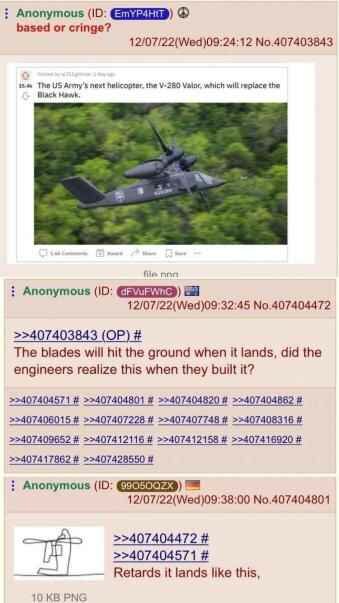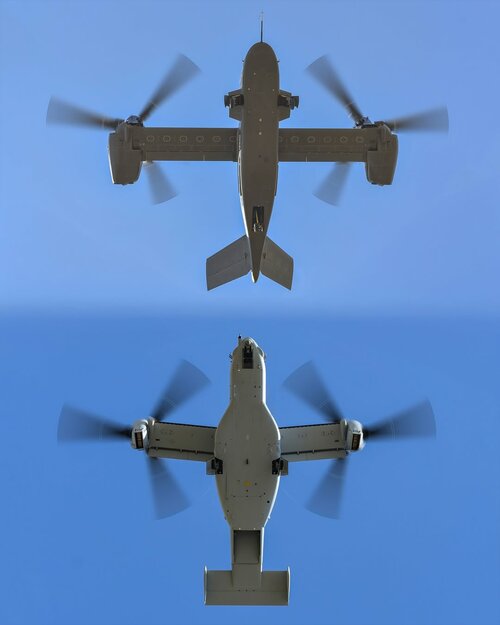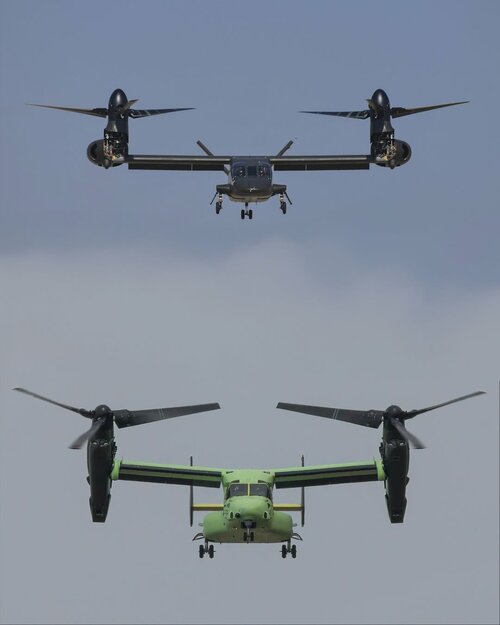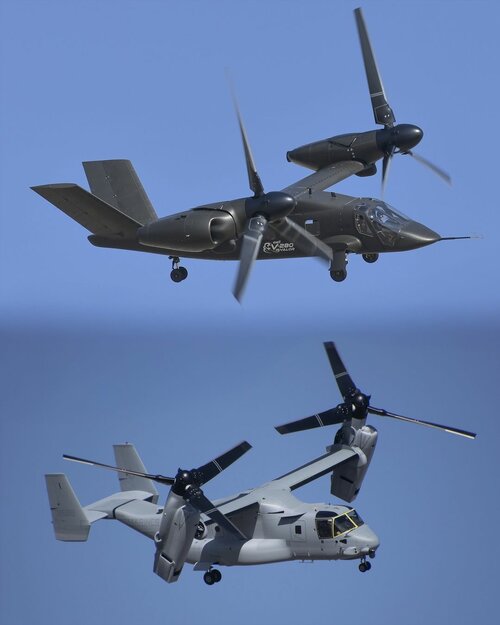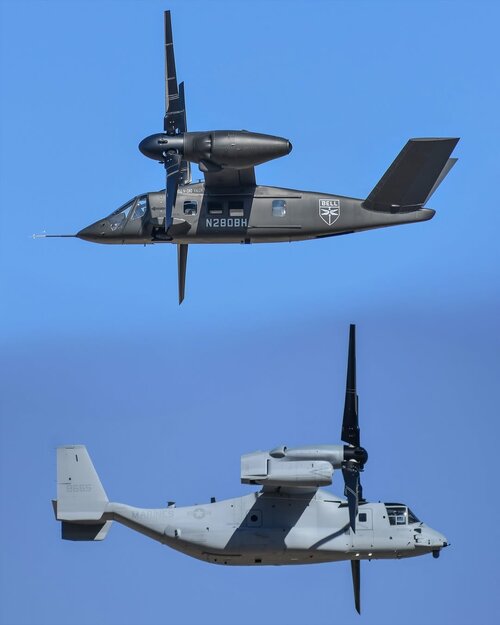You are using an out of date browser. It may not display this or other websites correctly.
You should upgrade or use an alternative browser.
You should upgrade or use an alternative browser.
Bell V-280 Valor
- Thread starter RavenOne
- Start date
e-Graphite
ACCESS: Confidential
- Joined
- 15 June 2023
- Messages
- 60
- Reaction score
- 133
The demonstrator used the T-64 engine instead of the T406/AE1107C the V-22 uses. The FLRAA engine will be a variant called AE1107F. The V-280 proprietors aren't the V-22's proprotors, either. Smaller diameter and higher flapping to meet the Army's agility targets. Being a demonstrator, there is probably some part reuse here and there, but to substantially expand flapping will be a bunch of new parts and the V-280 clearly doesn't have blade fold, so that's a new blade and new other details to capture that weight and complexity savings.I'd honestly thought that the V280 was already using the Osprey engines, not just the proprotors....
- Joined
- 18 October 2006
- Messages
- 4,202
- Reaction score
- 4,875
@Scott Kenny - Actually, the proprotors are significantly different. I do not recall the numbers, but the FLRAA will have ~ 5 degrees more flex than that of the V-22 for increased agility. The Bell demonstrator used CH-47 engines as there is an ample supply of them within the U.S. Army and they were 'Government Furnished Equipment' to keep cost down. When the dollars went aways for the Future Advanced Turbine Engine (FATE) program, both vendors were given authority to select engines for their aircraft.
- Joined
- 18 October 2006
- Messages
- 4,202
- Reaction score
- 4,875
Cerberus is not the radar. It's the AEW mission system, coupled with Searchwater radar. Crowsnest is also basically an updated Cerberus-Searchwater combo.Same radar. Cerberus is an improved version of Searchwater and is fitted on the Merlin AEW helos.

Bell launches campaign to sell Aussies V-280 Valor tiltrotor - Breaking Defense
A top Bell executive is spending this week's Land Forces conference meeting with top Australian Army officials to start pitching the V-280 Valor.
Scott Kenny
ACCESS: USAP
- Joined
- 15 May 2023
- Messages
- 11,184
- Reaction score
- 13,555
Honestly, just given Continental Aus, they need tilt-rotors of some flavor. Nevermind operations into the greater Pacific.
Bell launches campaign to sell Aussies V-280 Valor tiltrotor - Breaking Defense
A top Bell executive is spending this week's Land Forces conference meeting with top Australian Army officials to start pitching the V-280 Valor.breakingdefense.com
It's a long way between towns Down Under.
RavenOne
ACCESS: Top Secret
- Joined
- 18 June 2008
- Messages
- 996
- Reaction score
- 2,647
Bell actively launching campaign to sell the V-280 Valor to the Australian Defence Force

 breakingdefense.com
breakingdefense.com
cheers

Bell launches campaign to sell Aussies V-280 Valor tiltrotor - Breaking Defense
A top Bell executive is spending this week's Land Forces conference meeting with top Australian Army officials to start pitching the V-280 Valor.
cheers
Scott Kenny
ACCESS: USAP
- Joined
- 15 May 2023
- Messages
- 11,184
- Reaction score
- 13,555
Makes sense. It's a long way between towns Down Under.Bell actively launching campaign to sell the V-280 Valor to the Australian Defence Force

Bell launches campaign to sell Aussies V-280 Valor tiltrotor - Breaking Defense
A top Bell executive is spending this week's Land Forces conference meeting with top Australian Army officials to start pitching the V-280 Valor.breakingdefense.com
cheers
Nevermind trying to fly over the Pacific.
- Joined
- 4 July 2010
- Messages
- 2,507
- Reaction score
- 3,062
More testing with a mockup fuselage. Lots of effort going in to making the cabin work for the soldiers who will be using it.

 www.flightglobal.com
www.flightglobal.com

US Army’s Pacific combat troops already training on FLRAA tiltrotor
Infantry and aviation soldiers from the Hawaii-based 25th Infantry Division are drilling on a mock-up of Bell's Future Long-Range Assault Aircraft tiltrotor to help test cabin design and ergonomics for the aircraft, whose primary role will be ferrying assault troops into battle.
Forest Green
ACCESS: Above Top Secret
- Joined
- 11 June 2019
- Messages
- 9,328
- Reaction score
- 16,954

Army Already Preparing For V-280 Valor To Dramatically Transform Air Assaults
The V-280 will "deliver one Brigade Combat Team in one period of darkness, over 500 miles, arriving behind enemy lines, and be able to conduct sustained combat operations.” The Army is busy working on its concept of Large-Scale, Long-Range Air Assault, which will be enabled by the arrival of the...
That article is very light on info, sadly.
It suggests a whole brigade could be airlifted 500 miles away during one period of darkness. Is it 8 hours? or 16 hours?
If it's a 12 hour average, just how many trips and how many aircraft would be needed to airlift a whole brigade?
I assume we're talking about an air assault brigade with the lightest of equipment, but still, that's several hundred vehicles and trailers, on top of 3+ thousand personnel.
That's likely several hundred trips required. Mostly due to vehicles. (personnel alone could likely be ferried in 240 or so trips) It really depends on the number of vehicles/trailers/supplies carried, and that's something that I haven't managed to find, how many pieces of equipment does an air assault brigade use.
It suggests a whole brigade could be airlifted 500 miles away during one period of darkness. Is it 8 hours? or 16 hours?
If it's a 12 hour average, just how many trips and how many aircraft would be needed to airlift a whole brigade?
I assume we're talking about an air assault brigade with the lightest of equipment, but still, that's several hundred vehicles and trailers, on top of 3+ thousand personnel.
That's likely several hundred trips required. Mostly due to vehicles. (personnel alone could likely be ferried in 240 or so trips) It really depends on the number of vehicles/trailers/supplies carried, and that's something that I haven't managed to find, how many pieces of equipment does an air assault brigade use.
Last edited:
Also would be interesting to compare to deploying the same force by airdrop. A single A400M or C-17 can drop as many troops + equipment as a dozen V-280s, much faster and farther.It suggests a whole brigade could be airlifted 500 miles away during one period of darkness. Is it 8 hours? or 16 hours?
If it's a 12 hour average, just how many trips and how many aircraft would be needed to airlift a whole brigade?
I assume we're talking about an air assault brigade with the lightest of equipment, but still, that's several hundred vehicles and trailers, on top of 3+ thousand personnel.
A dozen A400Ms or C-17s = 144 V-280s!
Last edited:
- Joined
- 4 July 2010
- Messages
- 2,507
- Reaction score
- 3,062
Interesting news from TWZ coverage which wasn't in circulation before: the Army's wooden buck testing had 2 distinct (though not fully described) layouts and soldier feedback heavily (maybe unanimously) favored one configuration over the other. Encouraging as far as that goes.
Also, no cockpit doors on an Army rotorcraft is a bit surprising.
Also, no cockpit doors on an Army rotorcraft is a bit surprising.
- Joined
- 18 October 2006
- Messages
- 4,202
- Reaction score
- 4,875
The division conducting the brigade air assault (101st AASLT) has four times the CH-47 of other divisions to move outsized loads. The division commander pointed out he needed three FARP to do the mission vice ten with UH-60. Those FARP are most likely primarily for the CH-47 carrying the artillery, command vehicles, ammo, and medical forward.
While fixed wing lift platforms could certainly paradrop the troops, the fact that these aircraft are very critically precious assets for a theater commander, and you would be flying them just above stall speed at a perfect altitude for every weapon from .50 caliber on up through MANPADs and tactical air defenses, with 100+ troops in each one, makes the proposition extremely high risk. 300 troops and aircrews dead before you even start the fight, would not play well politically.
While fixed wing lift platforms could certainly paradrop the troops, the fact that these aircraft are very critically precious assets for a theater commander, and you would be flying them just above stall speed at a perfect altitude for every weapon from .50 caliber on up through MANPADs and tactical air defenses, with 100+ troops in each one, makes the proposition extremely high risk. 300 troops and aircrews dead before you even start the fight, would not play well politically.
Dilandu
I'm dissatisfied, which means, I exist.
One problem; the chances of C-17 surviving till the drop are orders of magnitude less than of V-280. And V-280 could actually land troops, not merely drop them around to be massacred by enemy FPV drones. The era of paratroopers is over.Also would be interesting to compare to deploying the same force by airdrop. A single A400M or C-17 can drop as many troops + equipment as a dozen V-280s, much faster and farther.
RavenOne
ACCESS: Top Secret
- Joined
- 18 June 2008
- Messages
- 996
- Reaction score
- 2,647
Just touching back on the proposed naval / maritime strike variant (that would be partnered with unmanned V-247) , and the proposed USMC variant - has there been any talk of the USCG having interest in V-280, out of interest?
Just referencing a conversation i briefly had last week at European Rotors in Amsterdam, but it wasnt with Bell before anyone asks.
cheers
Just referencing a conversation i briefly had last week at European Rotors in Amsterdam, but it wasnt with Bell before anyone asks.
cheers
- Joined
- 18 October 2006
- Messages
- 4,202
- Reaction score
- 4,875
I suspect the value to the USCG will depend on the downwash produced by the aircraft. It may have wonderful range and speed, but if it cannot safely conduct hoist operations it would probably not be worth the cost to them. I cannot see the cost being worth it for a reconnaissance platform.Just touching back on the proposed naval / maritime strike variant (that would be partnered with unmanned V-247) , and the proposed USMC variant - has there been any talk of the USCG having interest in V-280, out of interest?
Just referencing a conversation i briefly had last week at European Rotors in Amsterdam, but it wasnt with Bell before anyone asks.
cheers
There is some solutions today to bypass the problem of downwash.
Also, being able to discontinue the need to have long range rescue mission supplemented with C-130 for aerial refueling will easily justify getting a USCG derivative to offset the cost of manpower and sustainment. Especially when Americans are reaching farther out at sea with larger boats, more frequent travels and increased occurrence of serious weather events.
It could also raise Guardians own safety with rescue being flown in pair due to the offset of manpower from larger airframe and long range that will allow backups to join from more stations.
I can´t really see any downside.
Also, being able to discontinue the need to have long range rescue mission supplemented with C-130 for aerial refueling will easily justify getting a USCG derivative to offset the cost of manpower and sustainment. Especially when Americans are reaching farther out at sea with larger boats, more frequent travels and increased occurrence of serious weather events.
It could also raise Guardians own safety with rescue being flown in pair due to the offset of manpower from larger airframe and long range that will allow backups to join from more stations.
I can´t really see any downside.
- Joined
- 16 April 2008
- Messages
- 9,558
- Reaction score
- 14,337
There is some solutions today to bypass the problem of downwash.
Also, being able to discontinue the need to have long range rescue mission supplemented with C-130 for aerial refueling will easily justify getting a USCG derivative to offset the cost of manpower and sustainment.
Not sure why you are talking about aerial refueling here -- the USCG doesn't do it, except for helicopter in-flight refueling from surface ships.
HaveVoid
ACCESS: Restricted
- Joined
- 4 October 2010
- Messages
- 32
- Reaction score
- 95
Not sure why you are talking about aerial refueling here -- the USCG doesn't do it, except for helicopter in-flight refueling from surface ships.
I can’t speak for Tomcat, but I’ve seen the belief that USCG must do aerial refueling because of the HC-130 designation of their Hercules aircraft and the existence of the HC-130P, etc. in the USAF which do helicopter aerial refueling.
In reality they are distinct birds with different mission sets, but it is confusing to keep them straight.
@TomS : Isn´t the USAF providing SAR at sea when required? I seem to recall missions with refueling involving HC-130P.

 www.dvidshub.net
www.dvidshub.net
With a long range self deployable and fast a/c like the Valor, the USCG could increase the number of missions it can sustain independently with less airframe.

Long-range rescue at sea
In a concerted effort throughout July 7, 2017 and into the early hours of July 8, approximately 80 Citizen Airmen and four aircraft from the 920th Rescue Wing, Patrick Air Force Base, Florida, successfully rescued 2 German citizens whose vessel caught fire approximately 500 nautical miles off...
With a long range self deployable and fast a/c like the Valor, the USCG could increase the number of missions it can sustain independently with less airframe.
Last edited:
Firefinder
ACCESS: Top Secret
- Joined
- 5 October 2019
- Messages
- 1,038
- Reaction score
- 1,876
Those are USAF Pave Hawks and HC130s not the USCG Jay Hawks and HC130s.@TomS : Isn´t the USAF providing SAR at sea when required? I seem to recall missions with refueling involving HC-130P.

Long-range rescue at sea
In a concerted effort throughout July 7, 2017 and into the early hours of July 8, approximately 80 Citizen Airmen and four aircraft from the 920th Rescue Wing, Patrick Air Force Base, Florida, successfully rescued 2 German citizens whose vessel caught fire approximately 500 nautical miles off...www.dvidshub.net
With a long range self deployable and fast a/c like the Valor, the USCG could increase the number of missions it can sustain independently with less airframe.
Thats the Air Force craft with Air Force organic rescue Pilots, you can tell by the liverary. All Coast Guard Craft use the icon White with Red.
The Coast Guard basically called the air force and ask/Told them to send a set of THEIR copters with their Tanker support to go help cause none of the CG birds have the range.
The Coast Guard Birds, both the HC130s and the Jayhawks, lack any mid air refueling gear since their primary zone is well within the 275 mile + 30 minute loiter radius of the copters. Coast Guard Birds have more range [bout 300-500 mile] over the military counterparts due to dropping armor and weapons for more fuel.
The Air Force helps with the extreme range missions like the post as needed cause it both the Right Thing to Do, and it help training the crews in doing Stressful operations due to the similarities.
The only major Area of Operations that will need the Valor range and speed is up by Alaska and the weather bad enough to often ground them anyways.
Edit: Now if the Valor starts replacing the The Blackhawk Family enmass I can see the CG switching for logistical reasons.
Last edited:
Scott Kenny
ACCESS: USAP
- Joined
- 15 May 2023
- Messages
- 11,184
- Reaction score
- 13,555
That's what I expect to happen.Edit: Now if the Valor starts replacing the The Blackhawk Family enmass I can see the CG switching for logistical reasons.
The entire Army fleet will be some 2500 Valors assuming a 1:1 replacement for Blackhawks, while the USN has 450 Seahawks. Due to the hangar limits, I expect the USN to stick with Seahawks and just upgrade the engines to T901s.
As long as the Valors aren't impossible to do hoist work under, I expect the USCG to want Valors instead of Super Seahawks from the Navy. Because better speed and range is ideal for SAR work.
- Joined
- 18 October 2006
- Messages
- 4,202
- Reaction score
- 4,875
$$$There is some solutions today to bypass the problem of downwash.
Also, being able to discontinue the need to have long range rescue mission supplemented with C-130 for aerial refueling will easily justify getting a USCG derivative to offset the cost of manpower and sustainment. Especially when Americans are reaching farther out at sea with larger boats, more frequent travels and increased occurrence of serious weather events.
It could also raise Guardians own safety with rescue being flown in pair due to the offset of manpower from larger airframe and long range that will allow backups to join from more stations.
I can´t really see any downside.
The entire Army fleet will be some 2500 Valors assuming a 1:1 replacement for Blackhawks, while the USN has 450 Seahawks. Due to the hangar limits, I expect the USN to stick with Seahawks and just upgrade the engines to T901s.
I'm not sure if there is an official procurement quantity of record, but here are some approximate comments from army brass:
Also speaking at AUSA today, Maj. Gen. Clair Gill, Commanding General at the U.S. Army Aviation Center of Excellence and Fort Novosel, said that the future force mix will come down to the specific situation and operational demands at the time — as well as budgetary constraints.
“Would I love to put a FLRAA everywhere that there’s a Black Hawk? Sure. Do I think it’s affordable? Probably not,” Gill told reporters.
“The Black Hawk is coming up on 40 years old, I believe, and my sense is the Black Hawk is going to compete with the B-52 and C-130 for going the distance. We’re going to have Black Hawks in our formation as long as any of us are reading the news.”
“I think FLRAA is going to come on.” Gill continued. “We’re going to learn a lot about it. We’re going to scale it. We’re going to see where we are in the 2030s, once we go to full-rate production and we get that first limited test unit out, learn a lot about it, we got to figure out how we train it. We start proliferating it. And if it, if it is that game-changing technology and everybody says that we’ve got to double down, then maybe we buy more. But I think initially it’s going to be some sort of a mix, and I don’t see the Black Hawk going away.”

Army Already Preparing For V-280 Valor To Dramatically Transform Air Assaults
The V-280 will "deliver one Brigade Combat Team in one period of darkness, over 500 miles, arriving behind enemy lines, and be able to conduct sustained combat operations.” The Army is busy working on its concept of Large-Scale, Long-Range Air Assault, which will be enabled by the arrival of the...
Scott Kenny
ACCESS: USAP
- Joined
- 15 May 2023
- Messages
- 11,184
- Reaction score
- 13,555
Which says that the Army really want to buy 2500 Valors, and just need to figure out how to pay for them all.I'm not sure if there is an official procurement quantity of record, but here are some approximate comments from army brass:
I'd guess that the USAF would be willing to replace their 223x Pave Hawks with Valors for the CSAR role. They might even swap out their CV22s if the Valors have similar range/speed. (Not sure here, but usually CSAR is rescuing maybe a half dozen people so the Ospreys are a lot bigger than needed)
USMC would be in for another ~160 Valors plus ~160 gunship versions, to replace their H-1s. They'll probably jump in on the tail end of Army production because the Yankee and Zulu are still relatively new airframes.
USCG another 144+ (replacing 102 Dolphins and 42 Jayhawks), plus however many you want to swap from C-27Js (14) and HC-144s (18). I'm assuming that the USCG would not get rid of their HC-130s, but that'd be another 27 if they did. You might make an argument for the USCG picking up the USAF CV22s to replace the C-27Js and HC-144s, instead of Valors. Just to have some larger airframes for bigger rescue operations.
I still think that for what the Navy wants to do, they'll end up with T901 Super Seahawks instead of Valors, at least until the Burkes are out of service due to hangar size limits.
BlackBat242
OK, I changed my personal text ;)
- Joined
- 10 April 2013
- Messages
- 1,446
- Reaction score
- 4,142
USCG another 144+ (replacing 102 Dolphins and 42 Jayhawks), plus however many you want to swap from C-27Js (14) and HC-144s (18).
The HH-65s will be gone before the USCG begins to receive any "HV-280"s.
Coast Guard takes next steps toward all MH-60T helicopter fleet
The Coast Guard received approval from the Department of Homeland Security on Oct. 31, 2023, to proceed with acquisition program activities that will continue to extend the service life of the
www.dcms.uscg.mil
The Coast Guard received approval from the Department of Homeland Security on Oct. 31, 2023, to proceed with acquisition program activities that will continue to extend the service life of the existing MH-60T fleet as well as begin the Coast Guard’s transition to a rotary wing fleet consisting of all MH-60T aircraft. The MH-60T Acquisition/Sustainment Program is authorized to:
- Move to full rate production of newly manufactured hulls as part of the service life extension program (SLEP) for the existing MH-60T fleet.
- Conduct Obtain Phase activities and execute low rate initial production of 12 aircraft that will transition three Coast Guard air stations currently operating with the MH-65 to the MH-60T.
Consolidation of the Coast Guard’s rotary wing fleet to a single MH-60T airframe is necessary to mitigate sustainability challenges with the MH-65 short range recovery helicopter and maintain the service’s rotary wing capability until recapitalization in line with the Department of Defense’s Future Vertical Lift program.
- Begin Obtain Phase activities for aircraft that will transition the remaining Coast Guard air stations to the MH-60T from the MH-65.
- Joined
- 6 September 2006
- Messages
- 4,816
- Reaction score
- 9,378
A Valor is never going to be suitable for all tasks, in reality a Valor/Blackhawk team seems very likely for the foreseeable future (just like the Huey lasted into the early Blackhawk years).
As Maj. Gen. Clair Gill says, if it does turn out to be the best thing since sliced bread, then they can always order more. Who knows, maybe the Valor has a 50-year production run ahead of it?
If it turns out more limited use than the Powerpoints said it would be, then at least you haven't wasted billions making thousands of the things.
As Maj. Gen. Clair Gill says, if it does turn out to be the best thing since sliced bread, then they can always order more. Who knows, maybe the Valor has a 50-year production run ahead of it?
If it turns out more limited use than the Powerpoints said it would be, then at least you haven't wasted billions making thousands of the things.
Scott Kenny
ACCESS: USAP
- Joined
- 15 May 2023
- Messages
- 11,184
- Reaction score
- 13,555
Okay, but the number of Coastie HV-280s is still on the order of 150, just replacing MH-60Ts and getting ordered in 15-20 years. (Assuming 1:1 replacement of Dolphins with MH60T Jayhawks)The HH-65s will be gone before the USCG begins to receive any "HV-280"s.

Coast Guard takes next steps toward all MH-60T helicopter fleet
The Coast Guard received approval from the Department of Homeland Security on Oct. 31, 2023, to proceed with acquisition program activities that will continue to extend the service life of thewww.dcms.uscg.mil
I'd still like to see the Coasties replace their C-27s and C-144s with Ospreys.
_Del_
I really should change my personal text... Or not.
- Joined
- 4 January 2012
- Messages
- 1,315
- Reaction score
- 1,802
Maybe as they start to age out with other services, a few can be transferred to them via GSA the way they came by their C-27's (sorry, Army).I wish the Coasties had a budget to even consider Osprey.
Still need to train pilots, maintain them, etc, but "free" is a magic word occasionally.
Scott Kenny
ACCESS: USAP
- Joined
- 15 May 2023
- Messages
- 11,184
- Reaction score
- 13,555
I was assuming that the Coasties would take over the USAF CV-22s.I wish the Coasties had a budget to even consider Osprey.
- Joined
- 18 October 2006
- Messages
- 4,202
- Reaction score
- 4,875
That might work, but only as long as the spare part pipeline is equally inexpensive. Also I am not sure the USCG has enough people to resource maintenance for Osprey, MH-60T, and C-130. "Aged Out" aircraft tend to be rather maintenance intensive.Maybe as they start to age out with other services, a few can be transferred to them via GSA the way they came by their C-27's (sorry, Army).
Still need to train pilots, maintain them, etc, but "free" is a magic word occasionally.
It would be interesting to see though.
Hi all, I've been following the V280 Valor project for a while now and I think it's a really cool looking aircraft. It's obviously still in a test phase and I think the look of the aircraft will change quite a bit when it goes in production, especially when the army or navy has certain demands and requirements.
I'm a VFX artist for The Netherlands and I decided to make my own (artist) impression of the aircraft and making it a special forces variant like the MH60 of the Night Stalkers. Those helicopters are packed with all sorts of sensors and little details which i think would look really cool on the V280. Here are some work in progress images of where I'm currently at. I really dislike the look of the cockpit windows of the test aircraft so i made them more like the UH-60 or AW139 helicopter, which looks way better in my opinion During my research for ref images I came across this forum so i thought maybe it's cool to share the work in progress with you guys. If you have some cool suggestions of things i can add please let me know!
During my research for ref images I came across this forum so i thought maybe it's cool to share the work in progress with you guys. If you have some cool suggestions of things i can add please let me know!
Cheers, Jonathan




I'm a VFX artist for The Netherlands and I decided to make my own (artist) impression of the aircraft and making it a special forces variant like the MH60 of the Night Stalkers. Those helicopters are packed with all sorts of sensors and little details which i think would look really cool on the V280. Here are some work in progress images of where I'm currently at. I really dislike the look of the cockpit windows of the test aircraft so i made them more like the UH-60 or AW139 helicopter, which looks way better in my opinion
Cheers, Jonathan
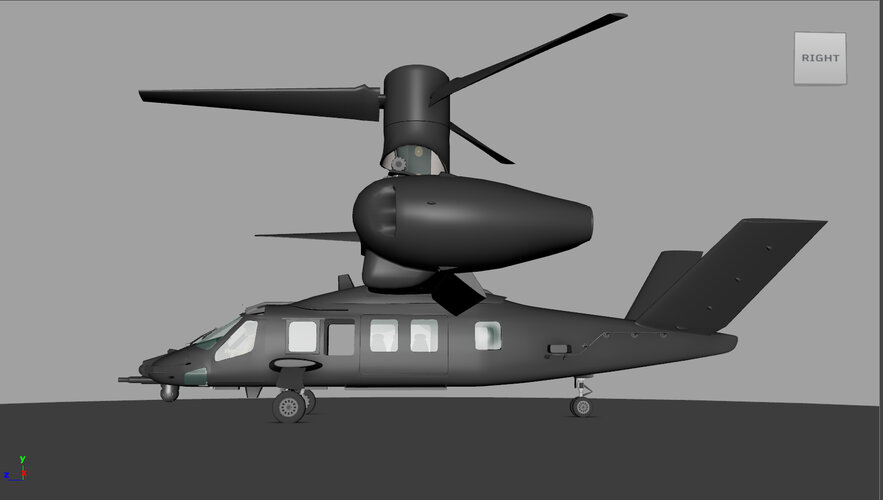
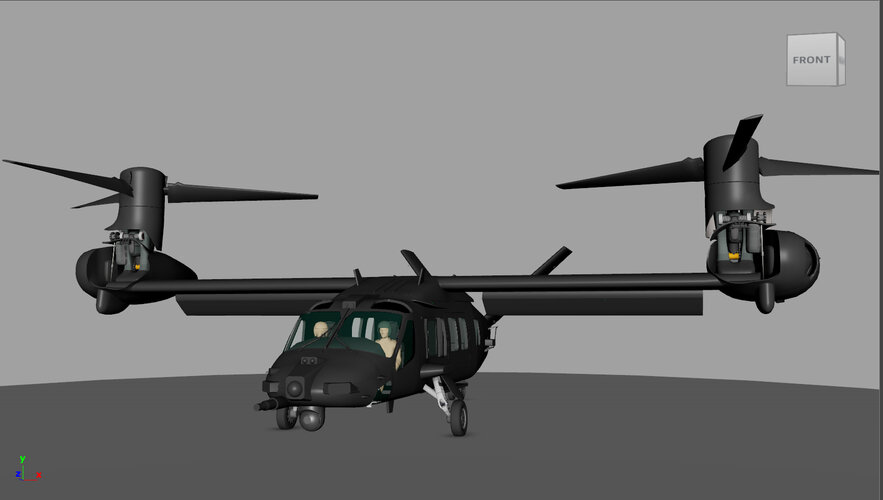
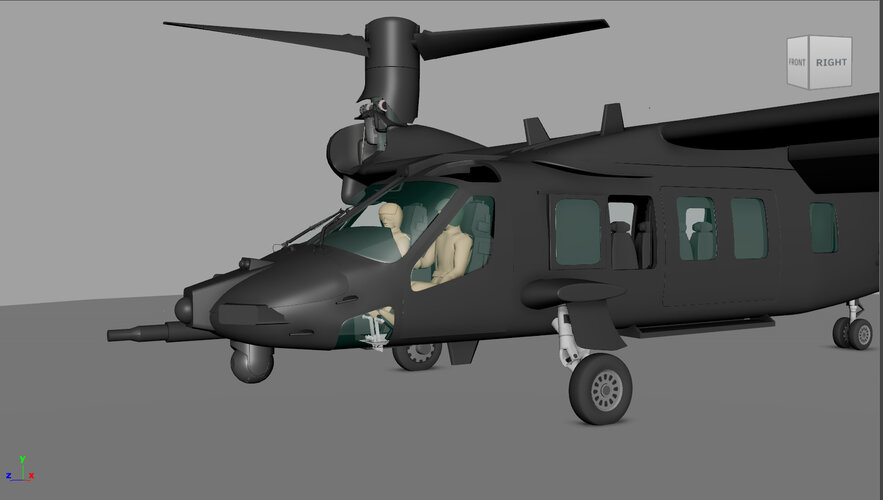

- Joined
- 18 October 2006
- Messages
- 4,202
- Reaction score
- 4,875
Excellent work Sir. The only observation I would make is that your aircrew are not scaled correctly. The aircraft is just about the same size as a UH-60 in length. So I would think a reduction of about .33% might be in order.
Hope to see you continue to post here.
To save you from the wraith of the staff ( grumpy lot) I might also recommend making a thread in the "user artwork and models."
Hope to see you continue to post here.
To save you from the wraith of the staff ( grumpy lot) I might also recommend making a thread in the "user artwork and models."
Attachments
Similar threads
-
Bell Boeing V-22 Osprey - Development and Proposed Variants
- Started by JC Carbonel
- Replies: 308
-
-
-
Army Indirect Fire Protection System and New Guided Missile Program
- Started by bobbymike
- Replies: 852
-
US Army's 1990s Armored Systems Modernization (ASM) Program (FIFV, Block III Tank, Crusader)
- Started by RyanC
- Replies: 77

